
Fraserburgh is a town in Aberdeenshire, Scotland with a population recorded in the 2011 Census at 13,100. It lies at the far northeast corner of Aberdeenshire, about 40 miles (64 km) north of Aberdeen, and 17 miles (27 km) north of Peterhead. It is the biggest shellfish port in Scotland and one of the largest in Europe, landing over 5,450 tonnes in 2016. Fraserburgh is also a major port for white and pelagic fish.
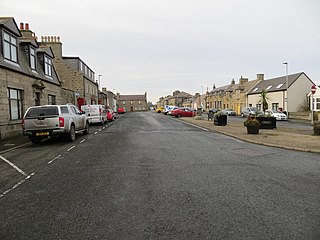
Rosehearty is a settlement on the Moray Firth coast, four miles west of the town Fraserburgh, in the historical county of Aberdeenshire in Scotland. The burgh has a population of approximately 1,300 with about 25 per cent of pensionable age.
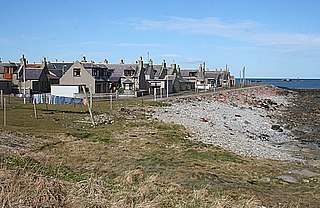
The villages of Inverallochy and Cairnbulg lie some 4 miles (6.4 km) east of Fraserburgh, in North East Scotland. It formerly consisted of the three fishing villages of Brandesburgh, Cairnbulg and Inverallochy, but the former village has since disappeared.

Kinnaird Head is a headland projecting into the North Sea, within the town of Fraserburgh, Aberdeenshire, on the east coast of Scotland. The 16th-century Kinnaird Castle was converted in 1787 for use as the Kinnaird Head Lighthouse, the first lighthouse in Scotland to be lit by the Commissioners of Northern Lights. Kinnaird Castle and the nearby Wine Tower were described by W. Douglas Simpson as two of the nine castles of the Knuckle, referring to the rocky headland of north-east Aberdeenshire. The lighthouse is a category A listed building. and the Wine Tower. is a scheduled monument. The buildings around the base of the lighthouse are the work of Robert Stevenson.

Peterhead is a town in Aberdeenshire, Scotland. It is Aberdeenshire's biggest settlement, with a population of 18,537 at the 2011 Census. It is the biggest fishing port in the United Kingdom for total landings by UK vessels, according to a 2019 survey.
The Frasers of Philorth are a Scottish lowland family, originally from the Anjou region of France. Castle Fraser, their family seat, is in Sauchen, Aberdeenshire, Scotland. Since the time of Alexander Fraser, 11th Lord Saltoun, the heads of the Philorth family are the Lords Saltoun. The current head of the Frasers of Philorth is Flora Fraser, 21st Lady Saltoun, who is Chief of the Name and Arms of Clan Fraser since 1 May 1984, by decree of the Court of the Lord Lyon. The family's arms are "azure, three cinquefoils argent"—three silver strawberry flowers on a field of blue. The heraldic cinquefoil is a stylized five-point leaf; the cinquefoils which appear on the Fraser of Philorth coat-of-arms are specifically strawberry flowers. Only the Lady or Lord Saltoun is permitted to display these arms plain and undifferenced.
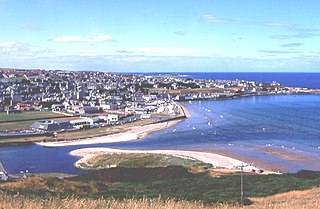
Banff is a town in the Banff and Buchan area of Aberdeenshire, Scotland. It is situated on Banff Bay and faces the town of Macduff across the estuary of the River Deveron. It is a former royal burgh, and is the county town of the historic county of Banffshire.

Broadsea is a community situated in Aberdeenshire in the north east of Scotland. It is a long-standing fishing community at the north edge of Fraserburgh.
The remains of the Castle of Lonmay are found near Netherton of Lonmay, to the north of Loch Strathbeg in Buchan, Scotland. The remains are not located in the modern village of Lonmay which is approximately 6 km to the south-west. It was described by W. Douglas Simpson as one of the nine castles of the Knuckle, referring to the rocky headland of North-East Aberdeenshire.

St Combs is a small fishing village in Aberdeenshire, Scotland, immediately southeast of Inverallochy. It has existed since at least the 17th century, and takes its name from a church to St Colm that used to exist in the area and was abandoned in 1607. Only a fragment of it remains. The remains of Lonmay Castle are also in the area. The village sits across Loch Strathbeg from Rattray.

Fordyce is a village in Aberdeenshire, Scotland that is slightly inland from the point where the Burn of Fordyce meets the sea between Cullen and Portsoy. It has existed since at least the 13th century. In 1990, Charles McKean wrote that Fordyce was "a sheer delight to discover, concealed as it is from the passing eye by hills and rolling countryside".
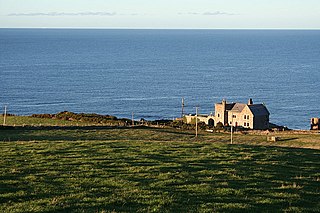
Dundarg Castle is a ruined castle about 2 kilometres (1.2 mi) north-northeast of New Aberdour, Aberdeenshire, Scotland, built within the ramparts of an earlier Iron Age promontory fort. It was described by W. Douglas Simpson as one of the nine castles of the Knuckle, referring to the rocky headland of North-East Aberdeenshire, and by Charles McKean as "Scotland's answer to Tintagel". It became a small Celtic monastery for a period.

Pitsligo Castle is a ruined castle half a mile east of Rosehearty, Aberdeenshire, Scotland. Modified in the 1570s by the Forbes of Druminnor, it was described by W. Douglas Simpson as one of the nine castles of the Knuckle, referring to the rocky headland of North-East Aberdeenshire. It is listed by Historic Environment Scotland as a scheduled monument.
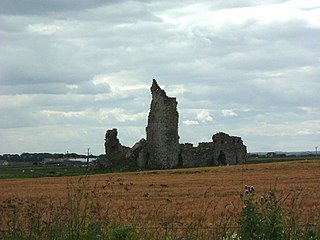
Inverallochy Castle is a ruined courtyard castle, near the village of Inverallochy in the Buchan area of North-East Scotland, dating to 1504. It lies 0.5 miles (0.80 km) south of Cairnbulg Castle, near Fraserburgh, and formerly stood beside the now-drained Loch of Inverallochy. It was described by W. Douglas Simpson as one of the nine castles of the Knuckle, referring to the rocky headland of North-East Aberdeenshire.

Pittulie Castle is an oblong tower house probably dating from 1596, half a mile from Pitsligo Castle, Rosehearty, Aberdeenshire, Scotland. It is a scheduled monument. Built by the Frasers of Philorth, it was described by W. Douglas Simpson as one of the nine castles of the Knuckle, referring to the rocky headland of north-east Aberdeenshire.
Auchmeddan Castle was a castle, most likely dating from the 16th century, now demolished, located 9 miles (14 km) west of Fraserburgh, at Mains of Auchmeddan, Aberdeenshire, Scotland. An alternative spelling was Auchmedden Castle.
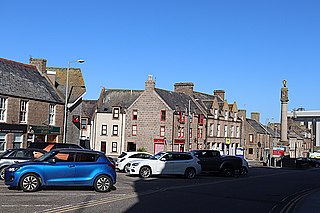
The Reform Monument is a Category B listed monument on Broad Street, at its junction with Longate, in Peterhead, Scotland, built in 1833. A Roman doric column, it is surmounted by arms of Earl Marischal, inspired by the gateway of Inverugie Castle.

Rathen is a parish and hamlet near Fraserburgh, Aberdeenshire, Scotland. In Scottish Gaelic, its name means fort on the river.

Dalyrmple Hall is a building in Fraserburgh, Scotland, standing on Dalyrmple Street at its junction with Station Brae. Category C listed, in the Scottish baronial style, it dates to 1881. Its architects were Aberdeen-based Jenkins & Marr.

Cruden Bay Hotel was a hotel in Cruden Bay, Aberdeenshire, Scotland. Following the success of the Palace Hotel in Aberdeen, it was built between 1897 and 1899 by the same owners. It closed in 1932 and was demolished between 1947 and 1952.


















